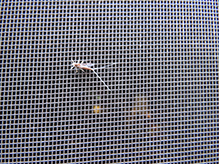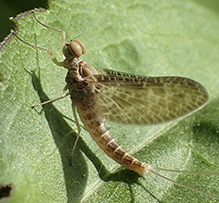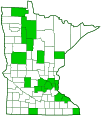Red speckled dun
(Callibaetis ferrugineus)
Conservation • Description • Habitat • Ecology • Distribution • Taxonomy
Conservation Status |
|||
| IUCN Red List | not listed |
||
| NatureServe | N5 - Secure SNR - Unranked |
||
| Minnesota | not listed |
||
Description |
Red speckled dun is a common small minnow mayfly. It occurs throughout the United States and southern Canada, and north along the West Coast to Alaska. The young (nymphs) are found in a number of aquatic habitats, including in still water in lakes and ponds, and in rapidly moving water in streams. Red speckled dun is small for a mayfly (order Ephemeroptera) but medium-sized for a small minnow mayfly (family Baetidae). Adults are about ½″ (12 mm) in length not including the tail filaments (cerci). The body is elongated, slender, and very soft. The coloration is highly variable, from pale brown to glossy brownish black. The antennae, though short and bristle-like, are very long for a mayfly. The mouth parts are small, poorly developed, and non-functional. The compound eyes on the female are on the sides of the head. On the male the compound eyes have additional large, turban-like parts that meet at the top of the head. These adaptations are said to allow the male, when in a swarm, to isolate females that are not yet paired with another male. There are two very long, hair-like sensory appendages (cerci) at the tip of the abdomen. They may be as long or longer than the body. The forewings are large and triangular, and they have many veins. They are held together above the body when at rest. The veins are white. The second terminal branch of the front (anterior) branch of the first fork of the media vein is designated as the M2 vein. The M2 vein is nearly straight. There is a dark brown or blackish-brown stripe along the leading edge (costal margin). The stripe is broad and deeply and irregularly eroded for most of its length, but it is narrow and straight near the wing tip. The remainder of the wing may be clear or mostly dark with clear borders along each cross vein. The hindwings are reduced to pads. The third segment (femur) of each leg is mostly pale yellowish-brown, darker just near the tip. On the hind legs the last part of the leg (tarsus), corresponding to the foot, has 3 or 4 segments. There are two subspecies of red speckled dun. The eastern subspecies Callibaetis ferrugineus ferrugineus occurs from the East Coast west to the Great Plains. The western subspecies Callibaetis ferrugineus hageni occurs from the West Coast east to the Great Plains. |
Size |
Body length: ½″ (12 mm) |
Similar Species |
Habitat |
|
Ecology |
Season |
|
Behavior |
|
Life Cycle |
|
Nymph Food |
Small aquatic organisms, algae, and organic debris |
Adult Food |
Adults do not feed |
Distribution |
||
|
Sources Biodiversity occurrence data published by: Minnesota Biodiversity Atlas (accessed through the Minnesota Biodiversity Atlas Portal, bellatlas.umn.edu, 9/19/2025). |
|
| 9/19/2025 | ||
Occurrence |
||
Common |
||
Taxonomy |
|
Order |
Ephemeroptera (mayflies) |
Suborder |
Pisciforma |
Family |
Baetidae (small mayflies) |
Genus |
Callibaetis (speckled duns) |
Subordinate Taxa |
|
red speckled dun (Callibaetis ferrugineus ferrugineus) red speckled dun (Callibaetis ferrugineus hageni) |
|
Synonyms |
|
Baetis ferrugineus Baetis tessellata Callibaetis americanus Callibaetis carolus Callibaetis coloradensis Callibaetis evergreenensis Callibaetis ferruginea Callibaetis fuscus Callibaetis hageni Callibaetis hebes Callibaetis nigritus Callibaetis tessellatus Cloe ferruginea |
|
Common Names |
|
red small minnow mayfly red speckled dun |
|
Glossary
Cercus
One of a pair of small sensory appendages at the end of the abdomen of many insects and other arthropods. In Odonata, one of the upper claspers. Plural: cerci.
Femur
On insects and arachnids, the third, largest, most robust segment of the leg, coming immediately before the tibia. On humans, the thigh bone.
Tarsus
On insects, the last two to five subdivisions of the leg, attached to the tibia; the foot. On spiders, the last segment of the leg. Plural: tarsi.
Visitor Photos
Share your photo of this insect.
This button not working for you?
Simply email us at info@MinnesotaSeasons.com.
Attach one or more photos and, if you like, a caption.
Nancy Lundquist |
 |
The tiny things fascinate me. |
Babette Kis |
 |
Callibaetis ferrugineus (red speckled dun) Callibaetis ferrugineus, red speckled dun mayfly, near the seasonal pond, which was almost dry. Photographed at Barnes Prairie, Racine Co., WI on June 1, 2022. |
MinnesotaSeasons.com Photos
|

Slideshows

Visitor Videos
Share your video of this insect.
This button not working for you?
Simply email us at info@MinnesotaSeasons.com.
Attach a video, a YouTube link, or a cloud storage link.
Other Videos

Visitor Sightings
Report a sighting of this insect.
This button not working for you?
Simply email us at info@MinnesotaSeasons.com.
Be sure to include a location.
MinnesotaSeasons.com Sightings



